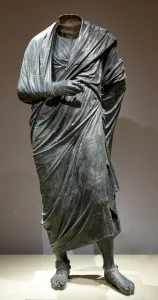The Cleveland Museum of Art is now suing the Manhattan district attorney’s office over confiscating allegedly looted antiquities. Over the past year, the Manhattan DA’s office has been rather busy, looking all over the country for potentially stolen or looted artworks. These artworks are normally either ancient artifacts or more modern art stolen from private collections by the Nazis in the 1930s and 1940s. The Cleveland Museum received a visit from New York investigators in late August, where they seized one of the centerpieces of the museum’s Greco-Roman antiquities collection: a large bronze Roman statue believed to represent the emperor Marcus Aurelius.
The Marcus Aurelius bronze is part of a group of Roman statues looted from the Bubon archaeological site in Turkey soon after its discovery in the 1960s. New York’s Metropolitan Museum of Art had bronze statues from the same site, that is until April when the Manhattan DA’s office seized these as well. The Cleveland Museum acquired the headless Marcus Aurelius statue in 1986 for $1.85 million (today, it is valued at $20 million). Previously, it belonged to Boston collector Charles Lipson, who very coincidentally bought the statue and three others in 1967, not long after the Bubon site’s discovery. Until the seizure, museum specialists referred to the statue as The Emperor as Philosopher, probably Marcus Aurelius. However, in an attempt to refute claims that this is the same Marcus Aurelius statue looted from the Bubon site, the museum has renamed the statue Draped Male Figure. When news of the seizure first broke, I noticed this, writing, “So, the statue is Marcus Aurelius when it comes to attracting new visitors, but not what it needs to go back where it came from?”
The Cleveland Museum has now sued the district attorney in federal district court in Ohio, saying that the investigators’ evidence was insufficient to warrant a seizure. The museum does not deny that the DA’s office does good work in helping repatriate stolen art and artifacts, but they say that “this is not one of those times”. They dispute the DA’s assertions that the statue came from Turkey and that it depicts Marcus Aurelius. The Cleveland Museum argues that the statue couldn’t possibly be Marcus Aurelius since the subject’s clothing is clearly modeled after a typical Greek philosopher rather than a general, a statesman, or an emperor. However, before this incident, the statue’s dress precisely led specialists to assume that it was a Marcus Aurelius statue in the first place. Marcus Aurelius was not only an admirer of Greek philosophy but a philosopher himself, becoming one of the most prolific figures within Stoicism. His book Meditations is regarded as Stoic philosophy’s quintessential work. This is not speculation; this is what the Cleveland Museum literally wrote for the statue’s description on their website.
The matter is currently before Judge Charles Fleming of the district court of the Northern District of Ohio, who will decide whether or not the Cleveland Museum is the statue’s rightful owner.

